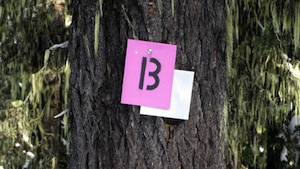The south side of Mt. Hood has a rich history of what we would today call “out-of-bounds” or “sidecountry” skiing – what early Oregonians simply called trail skiing.
Sidecountry skiing has become increasingly popular in recent years, and when you do it right it can be a lot of fun. Just see how criss-crossed the terrain is just west of the Timberline Ski Area on Mount Hood. As compared to true back-country skiing, where you venture into the wilderness, sidecountry skiing is done just off to the side of a ski area but within reach of the lifts. The uphill transportation is usually provided by lifts, followed by some traversing or even a bit of additional climbing, and then skiing or riding in ungroomed and out-of-bounds areas, but with the ultimate goal of returning to the lifts or to other signs of civilization, such as when skiing from Timberline back down to Government Camp.
Some people like to keep their favorite stashes secret, but I prefer to share them with anyone who is interested. And I like to take the opportunity to insert a few safety tips and pointers. For example:
- Don’t go out of bounds alone. A buddy can help you if something unexpected happens.
- Register in the climbers’ room at the entrance to the day lodge at Timberline. Get a free Wilderness permit there, and leave a form there stating your intended route.
- Carry a cell-phone and a 2-way radio, just in case, but know that reception might not be available everywhere.
- Cary a whistle. It can be heard from a greater distance than yelling.
- Use Mt. Jefferson as a landmark guide. When you are west of Timberline, Mt. Jefferson will always guide you back to the ski area, or at least back toward Government Camp – if you are at a lower elevation.
- Exit Zig Zag canyon after just a few turns. Exit Little Zig Zag canyon before you reach the tree line. Don’t go into Sand canyon unless you want to ski down to Government Camp. There is no easy return from Sand Canyon to the lifts.
- Your first excursion out of bounds should preferably be with someone who knows the terrain and who can tell you where the safety boundaries are.
Timberline’s official policy is to discourage out-of-bounds skiing because the terrain is unpatrolled, ungroomed, and potentially unsafe. The exact wording of Timberline’s policy is as follows:
“Accepting the risk of skiing or snowboarding beyond the boundary should only be considered with the following:
a) proper avalanche education
b) proper avalanche equipment & training (probe, shovel & beacon)
c) being with a knowledgeable group or “buddy”
d) backcountry travel knowledge and experience
e) knowledge of local conditions including snow pack history
Ski and Snowboard tracks may lead beyond Timberline’s boundary to where there is NO avalanche control, NO trail signs, CONFUSING route directions and DANGEROUS terrain traps. Rescue, if possible, will be slow and may be costly to you.”
But people have been skiing these “out of bounds” areas for a long time. Nearly 100 years ago early Oregonians established the Blossom, Glade, and Alpine trails. In the 1920s and 1930s, it was common practice to climb up from Government Camp on skis equipped with skins to the tree-line and then ski back to town.
A small cabin was built for the hikers and skiers near the intersection of present day Timberline trail (which at this point coincides with the Pacific Crest Trail) and the Mountaineer trail. The location is out of bounds, just slightly west of the upper part of the Kruser trail. It’s the only natural flat spot for miles around. It was known simply as the Timberline Cabin. All that remains of it today is some crumbling foundations, remnants of the chimney, and a historic marker indicating the spot. The marker and the foundations are visible in the summer months, but in winter, they are both buried under several feet of snow.
Timberline’s sidecountry is best visited in the Spring, when the snow settles into a firm base, and when the sun has softened up the top layer, providing a nice carpet of soft snow to ski on. Any intermediate skier or snowboarder can do it.
Depending on the time of year, the snow conditions, and the available lifts, it is possible to explore three distinct regions: Lower, Middle, and Upper.
Last modified: May 6, 2014


